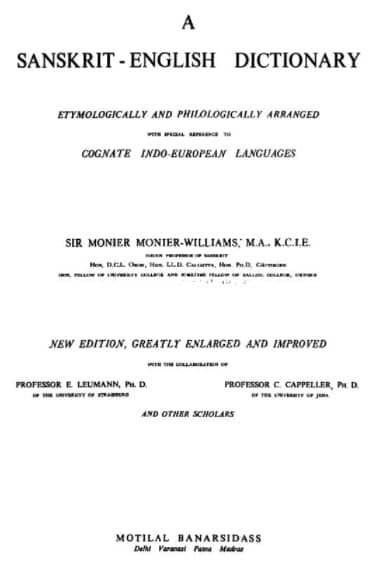‘Sanskrit To English Dictionary’ PDF Quick download link is given at the bottom of this article. You can see the PDF demo, size of the PDF, page numbers, and direct download Free PDF of ‘Sanskrit Dictionary’ using the download button.
A Sanskrit English Dictionary Book PDF Free Download

Sanskrit Dictionary Book
Statement of the circumstances which led to the peculiar Spes of Sankrit Lexicography introduced for the first time in the Mouler-Williams Sanskrit-English Dictionary of 1872
1 stated in the Preface to the first edition of this work written in that I had sometimes been shed by men caramel is at the classical lore of Kape, whether Sanskrit had any literature.
happily, since then, great Alsace in the piston of Indian movies and the diffusion of a knowledge of Ladislaus been focused.
The fun and research of able Orientalists in almost every country have the conscience to this rest, and I venture to claim for the.
Oxipel Indian Innate and its staff of Processes and Tutore a large share in bap still pre Newnbelns much Goran prevails, eres mung nhcared Engine speakers.
In respect of the exact position occupied by are in India-is relationship to that of the spoken series of the cannery and the immensity of its rage in comparison with that of the date of Europe.
I may be permitted there to the receptionist what I have already stated in regard to the term Sankri, be kee explaining what exacerbates que te included under the term “Samlinerature
By Sanskrit, then, is meant the learned language of India-be the language of culture inhabits the language of its region, de feature, by any akad language.
But be sif spoken and written by dusted ca in all parts of the country, from Cashmere to Cape Comorin Inne Monday to Cakita and Medias.
Samskrit, in short, events, I case, the learned of the language Berge by the Indian teacher of the great again the In For, in part of fact.
Be it notified, at the very threshold, that there are four mutually correlated lines of Sanskrit words in this Dictionary: — (i) a main line in Nagari type, with equivalents in Indo-Italic type 1 ;
(2) a subordinate line (under the Nagari) in thick Indo- Romanic type 1 ;
(3) a branch line, also in thick Indo-Romanic type, branching off from either the first or the second lines with the object of grouping compound words under one head;
(4) a branch line in Indo-Italic type, branching off from leading compounds with the object of grouping together the compounds of those compounds.
Of course, all four lines follow the usual Sanskrit Dictionary order of the alphabet (see p. xxxvi).
The first or main line, or, as it may be called, the * Nagari line/ constitutes the principal series of Sanskrit words to which the eye must first turn on consulting the Dictionary.
It comprises all the roots of the language, both genuine and artificial (the genuine being in targe Nagari type), as well as many leading words, in small Nagari, and many isolated words (also in small Nagari), some of which have their etymologies given in parentheses, while others have their derivation indicated by hyphens.
The second or subordinate line in thick Indo-Romanic type is used for two purposes: —
(a) for exhibiting clearly to the eye in regular sequence under every root the continuous series of derivative words which grow out of each root ;
(5) for exhibiting those series of cognate words which, to promote facility of reference, are placed under certain leading words (in small Nagari) rather than under the roots themselves.
The third or branch line in thick Indo-Romanic type is used for grouping together under a leading word all the words compounded with that leading word.
The fourth or branch Indo-Italic line is used for grouping under a leading compound all the words compounded with that compound.
| Author | Sir Monier Williams |
| Language | English |
| Pages | 1378 |
| PDF Size | 349.3 MB |
| Category | Literature |
A Sanskrit English Dictionary Book PDF Free Download
